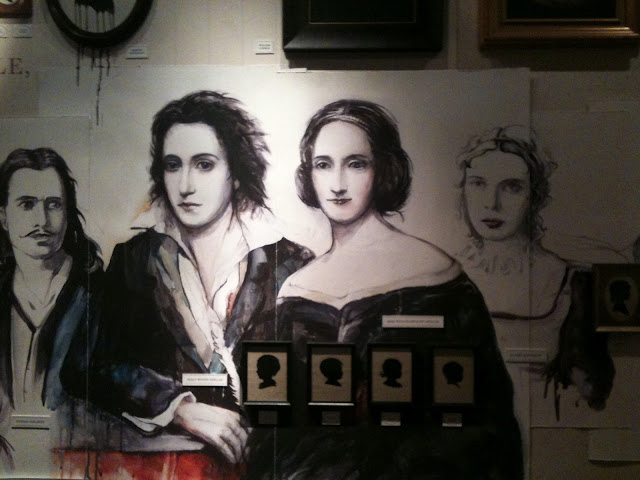Back in Brooklyn, with a knife wound got from aggressive cooking, I am scouring the internet for pictures of Montreux. God I miss Switzerland.
One last postscript before I close up this blog.
* * *
"Why is not life a continued moment where hours and days are not counted--but as it is a succession of events happen--the moment of enjoyment lives only in memory and when we die where are we?"
-Mary Shelley
* * *
The Shelleys were waiting for me in New York, too. At the fifth avenue branch of the New York Public Library, an exhibit co-curated by NYPL's own research librarian Elizabeth Denlinger has been on display all Spring, borrowed from the Bodelian library at Oxford. It's been up since March, but I deliberately saved this visit for after my trip, because I had a feeling I'd want one more mission on home turf to ease me back into real life. Mission #5: Shelley's Ghost, afterlife of a poet.
 It's only one small room on the main floor, an easy stop on your lunch break, and entry is free. It's mostly Percy, but there's a lot of Mary, Greatest Hits of the two of them and those related - and it's tiny! It's basically a room of curiosities, full of original artifacts, like Mary's Frankenstein manuscript with Shelley's edits in the margins, the London posters from the play Presumption: or The Fate of Frankenstein, locks of hair, a manuscript of an incomplete Kerouac play that involves the two of them, parts of Shelley's heart rescued from the ashes, the original "Journal of Sorrow" that Mary began after he died. It's a slim volume, and she's written inside the cover "Journal of Sorrow," giving her private grief an actual title, like any novel. Of all things, I found the sight of the small book the most touching. I've been reading the published versions of her journal and her letters, but nothing humanizes these people more than their own actual handwriting, which doesn't seem all that old or foreign. There's a mural of the major players - Trelawney, Byron, Jane Williams, stepsister Claire, etc - all looking terrifically windswept and anachronistic, with Mary and Shelley front and center, like the curtain call of a
play. Big heroes for bookish people. Young, young people who covered a lot of ground. The exhibit runs till June 24.
It's only one small room on the main floor, an easy stop on your lunch break, and entry is free. It's mostly Percy, but there's a lot of Mary, Greatest Hits of the two of them and those related - and it's tiny! It's basically a room of curiosities, full of original artifacts, like Mary's Frankenstein manuscript with Shelley's edits in the margins, the London posters from the play Presumption: or The Fate of Frankenstein, locks of hair, a manuscript of an incomplete Kerouac play that involves the two of them, parts of Shelley's heart rescued from the ashes, the original "Journal of Sorrow" that Mary began after he died. It's a slim volume, and she's written inside the cover "Journal of Sorrow," giving her private grief an actual title, like any novel. Of all things, I found the sight of the small book the most touching. I've been reading the published versions of her journal and her letters, but nothing humanizes these people more than their own actual handwriting, which doesn't seem all that old or foreign. There's a mural of the major players - Trelawney, Byron, Jane Williams, stepsister Claire, etc - all looking terrifically windswept and anachronistic, with Mary and Shelley front and center, like the curtain call of a
play. Big heroes for bookish people. Young, young people who covered a lot of ground. The exhibit runs till June 24.Climbing all those mountains and wandering all those cities destroyed my blue sneakers. So I left them in a trash can at Villa Danilo and used the extra suitcase space to bring back chocolate for the office and New Dramatists. Yesterday was Memorial Day, it is proper summer, and New York is already baking. Welcome home! Tonight, I'll put my Abruzzo culinary lessons to work, attempting sauteed dandelion greens and fettuccine with speck ham, porcini mushrooms, and truffles. For desert, an almond semifreddo that may or may not work out. I found the very last bottle of Pecorino wine in the wine shop on Columbus Circle. The store-owner said they used to have one other brand of Pecorino that was superior, but the distributor lost track of it and so they can't stock it anymore. Abruzzo is so far off the beaten track, nothing gets out. Who knew? I am actually glad to know that there are still things you have to cross oceans to taste.
Perspective, that's what they call it. It's why we go away, isn't it? But I suppose you can find a bit of it at home in the theater and at museums, which I should do a lot of this summer. I'm having an Ovidian June with String, the Fates musical I've written with Adam Gwon, then July and August will be entirely devoted to getting down everything I can think about the Shelleys for Katie Hathaway so we can go put that to music.
Thank you Lippman family for the grant, for thinking up such a grant, the kind that says "go live a little." I am a bit crazed over the thought that I'm not in Switzerland anymore, but maybe I'll get back there. Postscript finished. Back to business. Maybe write something.
 | ||
| In Montreux, which I loved the most. The shoe I left behind. |












































